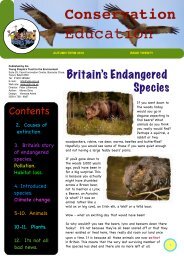How Animals Move - Young People's Trust for the Environment
How Animals Move - Young People's Trust for the Environment
How Animals Move - Young People's Trust for the Environment
- No tags were found...
You also want an ePaper? Increase the reach of your titles
YUMPU automatically turns print PDFs into web optimized ePapers that Google loves.
Furry FliersBats are <strong>the</strong> only mammals that can truly fly. Thereare approximately 1000 species of bats on Earth.Bats’ wings are very different from birds’ wings. Theyare membranes of skin stretched between <strong>the</strong> frontand back legs, ra<strong>the</strong>r like an umbrella. Bats are justlike mice that have developed wings and can now fly!Bats beat <strong>the</strong>ir wings up and down like birds and canreach speeds of up to 56kph (35mph).Did You Know?A fruit bat has a 2m wing spanFruit batsPhony FliersSome animals are called ‘flying’ but <strong>the</strong>y can’t actually fly properly. Flying Squirrels have skinbetween <strong>the</strong>ir front and back legs and <strong>the</strong>y glide between trees, a bit like using a parachute.Paradise tree snakes are excellent gliders, but <strong>the</strong>y don’t have skin flaps – <strong>the</strong>y hollow out <strong>the</strong>ir lowerbody to <strong>for</strong>m a kind of parachute and wiggle <strong>the</strong>ir tail like a rudder.Flying fish appear to fly above water to escape predators below. What <strong>the</strong>y are actually doing iswagging <strong>the</strong>ir tails really fast just in <strong>the</strong> water and using <strong>the</strong>ir front fins like wings to move through <strong>the</strong>air.Humming birdO<strong>the</strong>r minibeasts can move through <strong>the</strong> air without actually flying.Spiders, <strong>for</strong> example, can’t fly (phew!) but baby ones often use silk‘parachutes’ to float on <strong>the</strong> breeze to find new places to live.Did You Know?! Some butterflies flap <strong>the</strong>ir wings 100 times persecond! North American Monarch butterflies fly nearly2000km (1200 miles) to Mexico <strong>for</strong> <strong>the</strong> winter.Mini fliersSeveral types of minibeasts havewings and can fly. Some of <strong>the</strong>se havetwo wings (flies) and some have four(e.g. bees, butterflies).• Bees and wasps hook <strong>the</strong>irfront and back wings toge<strong>the</strong>r• Butterflies have four wings butfly as if <strong>the</strong>y only have two• Dragonflies also have fourwings but <strong>the</strong>y can move eachwing independently. Thismeans <strong>the</strong>y can dartbackwards and <strong>for</strong>wards veryfast and to stop suddenly.• The front pair of wings onbeetles is a horny shield thatprotects <strong>the</strong> delicate backwings, which <strong>the</strong>y use <strong>for</strong>flying.• Insect wings are kept strongby blood in <strong>the</strong> veins.• Ants only have wings <strong>for</strong> ashort time – when <strong>the</strong>y arefully-grown and ready to find amate. After mating <strong>the</strong>y lose<strong>the</strong>ir wings; sometimes <strong>the</strong>ychew <strong>the</strong>m off!






